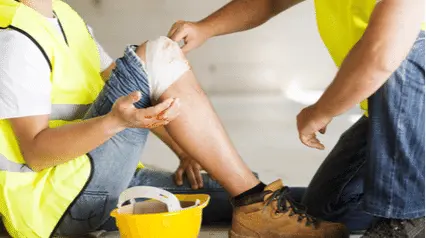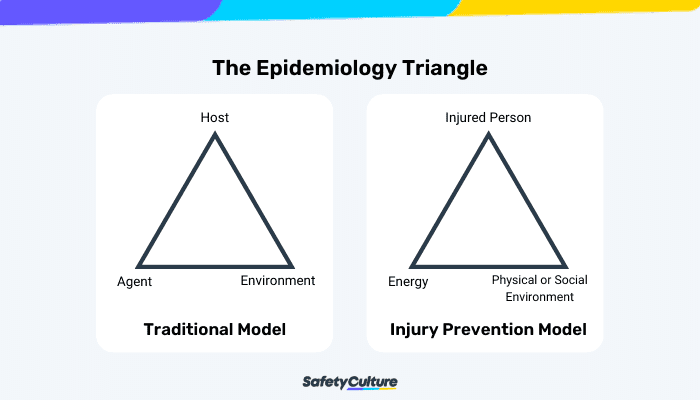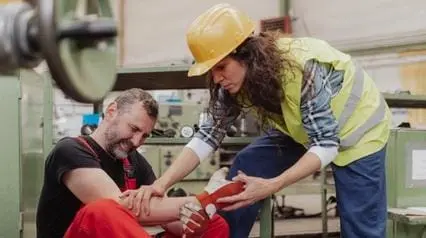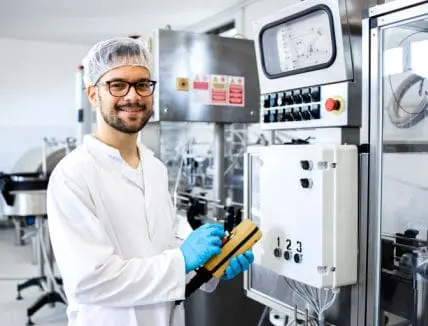What is Injury Prevention?
Injury prevention is an effort comprising risk assessment, hazard analysis, and inspection of the environment (e.g., home, sports facilities, or workplaces) in order to prevent or minimize the severity of physical injuries before they occur. Keeping people safe in any environment is the responsibility of safety and public health agencies; thus, injury prevention is an important component to improving the quality of life of the people.
According to the National Center for Biotechnology Information (NCBI), injury prevention is defined as “activities to prevent, ameliorate, treat, and/or reduce injury-related disability and death.”
Prevalence of Injury
According to the Centers for Disease Control and Prevention (CDC), the prevalence of injuries around the globe is that 1 out of 10 people are sent to the emergency department every year. It was recorded by the National Safety Council (NSC) in their NSC Injury Facts that in 2020, the US had 200,955 preventable deaths, 55.4 million injuries, and $1,158.4 billion dollars in costs.
In contrast to accidents, injuries are not the result of chance. Accidents and injuries are two entirely different things. However, they develop in a predictable manner, somewhat like disease. Before a potential injury occurs, it is possible to identify the risk factors. Therefore, identifying and assessing potential dangers can help to reduce the likelihood of injuries occurring in the first place.
Whether you are a professional athlete, a student, or a worker, injuries can happen suddenly at any place or time. However, there are measures or approaches that you can use to prevent or reduce the possibility of being injured.
Sports-related Injury
Sporting injuries are those suffered when participating in sports or physical activity of any kind. Sports injuries occur most frequently as a result of either trauma or overuse of muscles, joints, tendons, or bones when participating in or training in sports. The most common sports injuries include:
- Sprains
- Strains
- Bone fractures
- Ligament damage
- Bone Dislocations
- Concussions caused by hits, blows, shakings, or bumps
How Can Sports Injuries Be Prevented?
There are many ways to prevent sports injuries. Most injuries are caused by lack of training, improper sportswear, incorrect practices, and wrong sports equipment. The measures below can be used to prevent sports injuries:
- Warming up and cooling down properly—doing light exercises such as stretching or light cardio exercises can prepare the body for high impact; thus reducing the risk of an injury.
- Using correct techniques—doing the proper techniques learned in the training for the kind of sports the athlete is involved in. For example, in weight lifting, improper postures or stances can cause injuries.
- Wearing protective equipment and other gear—wearing protective equipment such as helmet for action sports and other gear like knee and elbow pads, eye protection, mouth guards, protective footwear, etc.
- Using suitable sports equipment—using proper equipment for a specific sport and a specific person. For example, lifting weights that are appropriate for the strength level of the player.
Work-related Injury
The NSC has provided statistics for the top work–related causes of injuries in 2020 on their website. The prevalence of these causes is a clear need for proper injury prevention measures. Below is a table showing the top 3 causes of work-related injuries with their examples and other information:
| TOP 3 OCCUPATIONAL INJURIES INVOLVING
DAYS AWAY FROM WORK IN UNITED STATES, 2020 |
||
| #1 | #2 | #3 |
| Exposure to harmful substances or environments | Overexertion, bodily reaction | Falls, slips, trips |
| Injury rate: 43.5 per 10,000 full-time workers | Injury rate: 26.2 per 10,000 full-time workers | Injury rate: 21.7 per 10,000 full-time workers |
| #1 because of COVID-19 cases | Age group most at risk: 45 to 64 | Age group most at risk: 55 and over |
Examples:
|
Examples:
Non-impact injuries: Result from excessive physical effort directed at an outside source; common activities include lifting, pushing, turning, holding, carrying, or throwing Repetitive motion: Microtasks resulting in stress or strain on some part of the body due to the repetitive nature of the task, typically without strenuous effort such as heavy lifting |
Examples:
Slips and trips without falling: Injuries occurring when a worker catches him/herself from falling due to slip or trip Falling on the same level: Includes tripping, slipping, falling while sitting, and falling onto or against object on the same level Falling to a lower level: Includes falling from a collapsing structure, falling through surfaces, and falling from ladders, roofs, scaffolding or other structures Jumping to a lower level: Different from falls because they are controlled and voluntary |
| Industry most at risk: health care and social assistance | Industry most at risk: transportation and warehousing | Industry most at risk: transportation and warehousing and agriculture |
| Typical days lost: 13 | Typical days lost: 14 | Typical days lost: 14 |
| Most frequent case type: Other diseases due to viruses, not elsewhere classified | Most frequent part of body hurt: back | Most frequent type of injury: sprains, strains, tears |
Injury Prevention Approaches
There are several preventive measures that are used to analyze risk factors in order to understand and predict patterns of injury or the likelihood of a risk to result in injury.
Levels of Prevention
Analysis of an injury or risk includes understanding the levels of the occurrence of the injury. Northwest Portland Area Indian Health Board (NPAIHB) has provided the 3 levels of prevention which refer to the timing of an injury as the start of analyzing risk factors for selecting what preventive strategy to take. They are:
- Primary level (Pre-event or before the event happened)—answering what can be done to avoid the injury before it occurs
- Secondary level (during the event)—answering what can be done to prevent or reduce the severity of the injury as it occurs
- Tertiary (Post-event or after the event happened)—answering what can be done to limit long-term impairments and disability after the injury occurs
CDC’s Public Health Approach
The CDC uses a systematic step-by-step process called the public health approach in addressing public health concerns, including injuries:
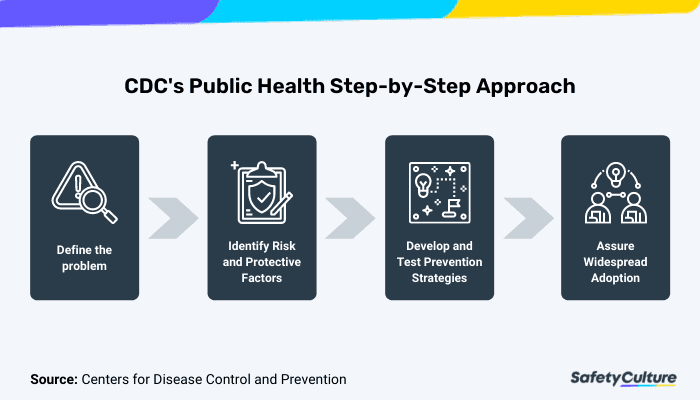
CDC’s Public Health Approach
- Step#1: Define the problem—this pertains to defining how big the problem is, where it is, and who is affected. This is accomplished through gathering and analyzing data (i.e., surveillance).
- Step #2: Identify risk and protective factors—this pertains to giving answers to questions such as, “What factors put people at risk for that injury?” and “What factors protect people from it?” The CDC conducts research from the answers collected and implements appropriate programs to protect people from getting injuries.
- Step #3: Develop and test prevention strategies—this pertains to putting into action the plans for injury prevention strategies. The CDC’s goal in studying these strategies is to determine how well they are working and if they need to be changed.
- Step #4: Assure widespread adoption—this pertains to spreading the information gathered from research and strategy development.
Adoption of the Epidemiology Triangle
Epidemiology is the study and analysis of the patterns and causes of disease and other health conditions, including injuries. As NPAIHB defined it, “epidemiology is the science of disease detectives.”
To identify the risk factors and the relationships that exist between them, epidemiologists use a triangular model for disease prevention. The same model can also be adopted to prevent injuries as well.
The injury prevention model shows the relationship between the three factors that influence the occurrence of injury. These factors are:
- Host – the injured person
- Environment – the characteristics of the physical and social environment
- Agent – the energy causing injury (e.g., mechanical, thermal, chemical, electrical, etc.)
The relationship between these factors means that each characteristic and behavior of a person or the environment can help or contribute to the likelihood of injury.
3 E’s Approach
Another well-known injury prevention framework is called the 3 E’s of Injury Prevention.
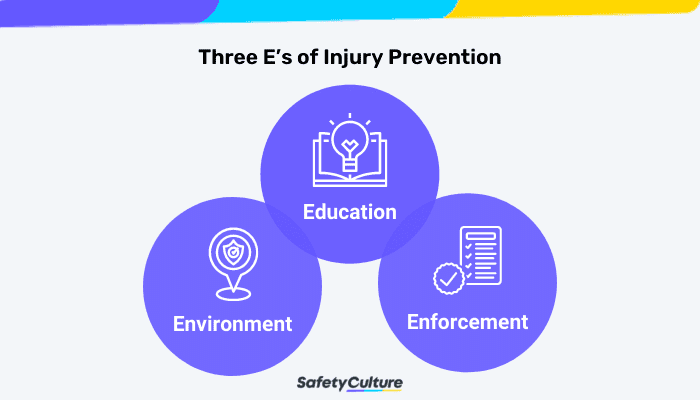
Three E’s of Injury Prevention
- Education—this pertains to teaching members of the organization about the potential hazards in their surroundings and providing information on how to avoid them at the same time. Education is sometimes interchanged by engineering. This means applying engineering controls to make the workplace safer.
- Environment—this pertains to the process of making a place safer. Safer working conditions may imply that the likelihood of suffering from the following hazards is minimal, depending on the type of workplace:
- Slippery floors
- Heavy machinery
- Loud noises
- Heat or cold
- Musculoskeletal Disorders (MSDs)
- Enforcement—this pertains to ensuring that all members of the organization are complying with safety standards, including those from the Occupational Safety and Health Administration (OSHA).
Improve your EHS Management
Cultivate a safe working environment and streamline compliance with our EHS solutions.
Explore nowSafetyCulture (formerly iAuditor) for Injury Prevention
Keeping everyone safe from the risk of getting injured is everyone’s responsibility. There are several ways or preventive approaches that can be implemented to prevent injuries. Without the proper tool to efficiently conduct risk assessments, inspections, and investigations, preventing the risk of injury can consume a lot of time which could have been used to take action on the hazards identified instead.
Empower your team, your community, or your workplace with SafetyCulture—the best tool to conduct digitized risk assessments and inspections to help identify hazards.
With SafetyCulture, you can identify and address the factors of the injury to consequently prevent it from recurring again. Additionally, you can:
- Identify potential hazards and select safety controls with digitized forms such as risk assessment templates.
- Observe tasks, the persons at risk, and select the risk rating based on the risk matrix using the Dynamic Risk Assessment Template Checklist.
- Educate your team or workers of the potential risks and the appropriate actions or safety measures that must be implemented with Training.
